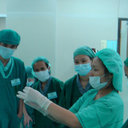Anesthetic Techniques and Perioperative Complications of Cleft Lip and Cleft Palate Surgery at Srinagarind Hospital.
Keywords
Abstract
BACKGROUND
Cleft lip (CL) and cleft palate (CP) are common craniofacial abnormalities with an incidence of around 1:800. Surgical are corrections often performed during the first year of life. These patients have risks for difficult intubation and various perioperative complications due to their young age and craniofacial abnormalities.
OBJECTIVE
The purpose of the retrospective descriptive study is to report the data of anesthetic techniques and complications of repairing CLCP in Srinagarind Hospital. These results could improve the caring and services for these groups of patients.
METHODS
Data was retrieved from anesthetic records of patients undergoing correction of CLCP from the period January 2005 to January 2009. Demographic data, clinical diagnosis, type operation, anesthetic technique, total opiod were analyzed using direct laryngoscopic view, grading intubation, method of intubation, and as well perioperative complications were also analyzed.
RESULTS
A total of 469 anesthetic records were obtained. The most common type of CLCP was unilateral side (45.48%). The highest incidence of difficult intubation was found in the CP and unilateral CLCP subgroup (4.48% and 4.48%, respectively). All patients were successfully intubated with a stylet except one patient, in whom retrograde intubation was used. Perioperative complications included desaturation, reintubation, postoperative bleeding, and post-operative nausea and vomiting (PONV). And the highest incidence of PONV was found in the CP (8.95%). Correlation between fentanyl using and postoperative desaturation was statistically significant when multivariate analysis was used (OR = 1.2; p = 0.01).
CONCLUSIONS
Patients with unilateral CLCP or CP had a higher risk for difficult intubation. Fortunately, all of the patients were successfully intubated with advanced anesthetists' skill. Long operative periods and a large dose of opioid could contribute to the postoperative desaturation and PONV.



